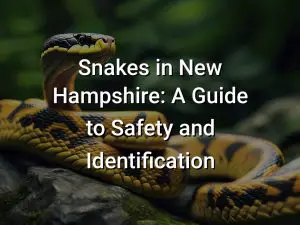Snakes in Michigan: Are They Dangerous?

Michigan may not be the first place that comes to mind when you think of snakes, but did you know that there are actually several different species of snakes in the state? If you’re curious about snakes and their presence in Michigan, you’ve come to the right place. In this article, we’ll explore the types of snakes found in Michigan, their behavior and habits, as well as snakebite prevention and treatment.
While most snakes in Michigan are harmless, it’s always good to be informed about the venomous ones and what to do in case of a snakebite. We’ll also discuss snake removal and conservation efforts in the state. So whether you’re a snake enthusiast or just curious about the snakes in Michigan, let’s dive in and learn more about these fascinating creatures!
Quick Links
Types of Snakes in Michigan
Michigan is home to a variety of snake species, both venomous and non-venomous. Here are some of the common types of snakes found in Michigan:
- Eastern Massasauga Rattlesnake: This is the only venomous snake in Michigan and is a rare sight. It can be identified by its gray or brown color, dark blotches, and small rattle at the end of its tail.
- Eastern Garter Snake: This is one of the most common and harmless snakes in Michigan. It has a long, slender body with three yellowish stripes running along its back.
- Eastern Milk Snake: Often mistaken for the venomous Eastern Massasauga Rattlesnake, this non-venomous snake has a similar color pattern but lacks the rattle. It has a reddish-brown body with dark blotches.
- Eastern Hognose Snake: Known for its upturned snout, this non-venomous snake is typically brown or gray with dark blotches. It has a unique defense mechanism of playing dead when threatened.
- Northern Watersnake: Found near bodies of water, this non-venomous snake has a thick body and varies in color from dark brown to gray. It often has dark blotches along its back.
It’s important to remember that most snakes in Michigan are non-venomous and pose no threat to humans. However, it’s always recommended to avoid approaching or provoking any snake you encounter in the wild.
Identification of Dangerous Snakes
When it comes to identifying dangerous snakes in Michigan, there are two main species to be aware of: the Eastern Massasauga Rattlesnake and the Eastern Massasauga Rattlesnake.
The Eastern Massasauga Rattlesnake is a venomous snake and is the only venomous snake species native to Michigan. It can be identified by its grayish-brown color, keeled scales, and diamond-shaped head. It also has vertical pupils and a rattle on its tail, which it uses as a warning signal when threatened. While its venom is potent, it is not typically aggressive and will generally only bite in self-defense.
The Eastern Massasauga Rattlesnake is a small snake, typically measuring around two to three feet in length. It prefers wetland habitats such as marshes, swamps, and bogs. It is a threatened species in Michigan and is protected by law.
The Eastern Hog-nosed Snake is another snake species in Michigan that is often mistaken as venomous due to its defensive behavior. It has a similar appearance to the Eastern Massasauga Rattlesnake, with a stocky body, keeled scales, and a distinct upturned snout. However, it is not venomous and is harmless to humans. When threatened, it will hiss loudly, flatten its neck, and may even play dead as a defense mechanism.
It is important to remember that while venomous snakes can be dangerous, they are generally shy and will avoid humans if given the opportunity. If you encounter a snake in Michigan, it is best to keep a safe distance and observe it from afar. If you believe it to be a dangerous snake, contact local authorities or a professional snake removal service for assistance.
Behavior and Habits of Michigan Snakes
Michigan is home to a variety of snake species, each with its own unique behaviors and habits. Understanding these behaviors can help you coexist safely with snakes in their natural habitats. Here are some common behaviors and habits of Michigan snakes:
- Thermoregulation: Like all reptiles, snakes are ectothermic, which means they rely on external heat sources to regulate their body temperature. In Michigan, snakes can be found basking in the sun or seeking shelter in cool, shaded areas to maintain their preferred temperature.
- Slithering and movement: Snakes move by slithering, using their muscular bodies and scales to push themselves forward. They can move quickly in a serpentine motion, allowing them to navigate various terrains, from grassy fields to forest floors.
- Hunting and feeding: Michigan snakes are carnivorous and feed on a diet of small mammals, birds, amphibians, and sometimes other snakes. They use their sense of smell and heat-sensing pits to locate prey, and some species, like the venomous Eastern Massasauga rattlesnake, have specialized venom to immobilize their prey.
- Reproduction: Michigan snakes reproduce sexually, with most species mating in the spring or early summer. Female snakes may lay eggs or give live birth, depending on the species. They generally do not exhibit parental care, and the young snakes are independent from birth.
- Hibernation: Snakes in Michigan are ectothermic, so they are unable to regulate their body temperature internally. During colder months, they enter a state of hibernation called brumation. They seek out underground burrows, rock crevices, or other protected areas to survive the winter.
- Defense mechanisms: When threatened, Michigan snakes have a variety of defense mechanisms to protect themselves. Non-venomous snakes may try to escape or use mimicry to resemble venomous species, while venomous snakes may strike and deliver a venomous bite as a last resort.
It is important to remember that most Michigan snakes are harmless and play a crucial role in the ecosystem by controlling populations of rodents and other small animals. If you encounter a snake in the wild, it is best to observe it from a safe distance and respect its space.
Venomous Snakes in Michigan
While Michigan is home to a variety of snakes, only one species is venomous: the Eastern Massasauga Rattlesnake (Sistrurus catenatus catenatus). This snake is considered relatively rare and is found primarily in wetland areas, such as marshes, swamps, and bogs.
The Eastern Massasauga Rattlesnake is a small venomous snake, typically measuring between 2 to 3 feet in length. It has a distinctive rattle at the end of its tail, which it uses as a warning signal when feeling threatened. However, it is important to note that not all Eastern Massasaugas will rattle before striking, so it’s important to exercise caution when in their habitat.
The venom of the Eastern Massasauga Rattlesnake is relatively mild compared to other rattlesnake species, but a bite can still cause significant pain, swelling, and tissue damage. If bitten by a venomous snake, it is crucial to seek immediate medical attention.
It is important to respect the habitat of these venomous snakes and observe them from a safe distance. If you encounter a snake and are unsure if it is venomous, it is best to assume that it is and give it space. Snakes play a vital role in maintaining the balance of ecosystems and should be appreciated from a distance.
If you suspect the presence of an Eastern Massasauga Rattlesnake or have concerns about snake populations in your area, it is recommended to contact your local wildlife agency or conservation organization for guidance.
Non-Venomous Snakes in Michigan
Michigan is home to several species of non-venomous snakes, which play an important role in the state’s ecosystem. These snakes are typically harmless to humans and can even be beneficial by controlling rodent populations. Here are some of the non-venomous snakes you might encounter in Michigan:
Garter Snake
The Garter Snake is one of the most common snakes found in Michigan. They are easily recognizable by their long, slender bodies and distinct stripes or patterns. Garter snakes are harmless to humans and feed on small prey such as insects, worms, and amphibians.
Brown Snake
The Brown Snake is a small snake that is often mistaken for a worm due to its size and slender appearance. They are usually brown or gray in color and have a smooth, shiny skin. Brown snakes primarily feed on earthworms and other small invertebrates.
Eastern Milk Snake
The Eastern Milk Snake is a medium-sized snake with a striking pattern of red, black, and white bands. Despite their name, Milk Snakes do not produce milk. They are called Milk Snakes because they were once believed to milk cows. These harmless snakes feed on small mammals, birds, and reptiles.
Eastern Hognose Snake
The Eastern Hognose Snake is known for its upturned snout and its ability to flatten its neck, similar to a cobra. While they may put on a defensive display by hissing and pretending to strike, they are harmless and rarely bite. Eastern Hognose Snakes primarily feed on toads and frogs.
Encountering a non-venomous snake in Michigan can be a fascinating experience. Remember to observe them from a safe distance and avoid attempting to handle or disturb them. It’s important to respect their natural habitat and appreciate their role in maintaining a balanced ecosystem.
Snakebite Prevention and First Aid
While encountering snakes in Michigan is relatively rare, it is important to take precautions to prevent snakebites and know how to administer first aid in case of an incident.
To prevent snakebites, follow these guidelines:
- Stay on designated trails and avoid tall grass, rocks, and logs where snakes may hide.
- Wear appropriate footwear, such as thick boots or closed-toe shoes, when exploring areas where snakes may be present.
- Avoid reaching into areas that you cannot see, such as crevices or holes in rocks.
- Keep your distance and do not attempt to handle or provoke snakes.
- Be cautious when stepping over logs or rocks, as snakes may be resting or sunning themselves in these areas.
If you or someone else is bitten by a snake, follow these first aid measures:
- Stay calm and try to identify the snake, if possible. This will help medical professionals provide appropriate treatment.
- Keep the affected limb immobilized and below heart level to slow the spread of venom.
- Remove any restrictive clothing or jewelry near the bite site.
- Clean the wound with mild soap and water, avoiding excessive scrubbing or bleeding.
- Apply a clean, sterile bandage or cloth to the wound to help control bleeding.
- Seek medical attention immediately. Call emergency services or go to the nearest hospital.
- Do not attempt to suck out venom or use a tourniquet, as these methods can do more harm than good.
Remember, prevention is key when it comes to snakebites. By staying cautious and informed, you can enjoy Michigan’s outdoor spaces with peace of mind.
Snakebite Treatment in Michigan
If you are unfortunate enough to be bitten by a snake in Michigan, it is important to seek medical attention immediately. While the majority of snakes in the state are non-venomous and their bites are not life-threatening, it is always better to err on the side of caution.
When being treated for a snakebite, remember the following:
- Stay calm and keep the affected area still, as movement can spread the venom more quickly.
- Remove any constricting items, such as rings or bracelets, from the affected area in case of swelling.
- Do not attempt to suck out the venom or cut the wound, as these methods are ineffective and can do more harm than good.
- Keep the wound below heart level to slow the spread of venom.
- Do not apply ice or a tourniquet, as these can cause tissue damage.
- Take note of the characteristics of the snake that bit you, if possible. This information can help medical professionals determine the appropriate treatment.
- Seek medical attention immediately, even if you believe the snake is non-venomous. Only healthcare professionals can properly assess and treat snakebites.
Remember, prevention is key when it comes to snakebites. By being cautious and avoiding interactions with snakes in the first place, you can greatly reduce the risk of being bitten. It is also important to educate yourself and others about snakes in Michigan to dispel any unnecessary fears or misconceptions.
Snake Removal and Control in Michigan
If you encounter a snake on your property or in your home in Michigan, it’s important to remember that snakes play a crucial role in the ecosystem and should generally be left alone. However, if you feel the need to remove or control snakes due to safety concerns or a snake infestation, it’s best to call a professional wildlife control expert.
Snake removal experts in Michigan are trained to safely and humanely remove snakes from residential and commercial areas. They have the knowledge and experience to identify snake species, locate their hiding places, and implement effective removal techniques.
When hiring a snake removal service, it’s essential to choose a licensed and reputable company that adheres to ethical practices and follows local regulations. They should use non-lethal removal methods whenever possible and prioritize the safety and well-being of both humans and snakes.
Preventing snakes from entering your property is also an important aspect of snake control. Here are some tips to help minimize the likelihood of snake encounters:
- Keep your yard clean and free of debris, including piles of leaves, wood, and rocks, as these can attract snakes.
- Seal any cracks or gaps in your home’s foundation, walls, or windows to prevent snakes from finding their way indoors.
- Ensure that your yard is well-maintained, with trimmed grass and vegetation, as snakes prefer areas with overgrown vegetation for hiding and hunting.
- Remove any potential snake food sources, such as rodents, which are attractive to snakes.
- Use snake repellents or barriers, such as snake fences or snake-proofing your property, to deter snakes from entering.
Remember, snakes are generally more scared of humans than we are of them. If you encounter a snake, keep a safe distance and avoid provoking or attempting to handle it yourself. Instead, contact a professional snake removal service in Michigan to ensure the situation is handled safely and responsibly.
Snake Conservation and Protection
Snake conservation and protection are important efforts to ensure the survival and well-being of snake species in Michigan. Snakes play a vital role in ecosystems as both predators and prey, helping to maintain a balance in the food chain.
One of the major threats to snake populations in Michigan is habitat loss. As urbanization and development continue to expand, snake habitats are being destroyed or fragmented. It is crucial to protect and preserve natural areas where snakes can thrive, such as forests, wetlands, and grasslands.
Another threat to snakes is persecution and misunderstanding. Snakes are often feared and killed due to misconceptions and fears of their venomous nature. Education and public outreach programs can help dispel myths about snakes and promote their conservation.
Efforts are also underway to protect endangered and threatened snake species in Michigan. The Eastern Massasauga rattlesnake, for example, is a federally threatened species that has seen a decline in population due to habitat loss and persecution. Conservation initiatives focus on habitat restoration, monitoring, and public awareness.
Additionally, laws and regulations are in place to protect snakes in Michigan. It is illegal to kill or harm most snake species, including venomous snakes, without a valid permit. These laws help ensure the survival and conservation of snake populations.
By supporting snake conservation and protection efforts, we can help preserve the biodiversity and ecological balance of Michigan’s ecosystems. Whether through habitat preservation, public education, or adherence to conservation laws, everyone has a part to play in ensuring the survival of these important creatures.
Encounters with Snakes in Michigan
Encountering a snake in Michigan can be a thrilling experience for nature lovers and outdoor enthusiasts. However, it is important to approach these encounters with caution and respect for these creatures.
When you come across a snake in Michigan, the first step is to give it space. Snakes are generally shy and will try to avoid humans whenever possible. Stay calm and observe the snake from a safe distance, making sure not to provoke or startle it.
It is important to remember that most snakes in Michigan are harmless and play a crucial role in the ecosystem by controlling rodent populations. However, it is always a good idea to familiarize yourself with the different snake species in the area to better understand their behavior and identify any potential dangers.
If you are unsure about the species or behavior of a snake you encounter, it is best to leave it alone and not attempt to handle or capture it. It is also important to teach children about snake safety and the importance of respecting and appreciating wildlife.
In the rare event of a snakebite, it is crucial to seek medical attention immediately. While most snakebites in Michigan are non-venomous and not life-threatening, it is better to err on the side of caution and let medical professionals assess the situation. Stay calm and try to remember as many details about the snake’s appearance as possible to help with identification and treatment.
Overall, encountering a snake in Michigan can be a fascinating experience. By understanding their behavior, taking precautionary measures, and respecting their habitat, you can safely appreciate these reptiles in their natural environment.
Conclusion
While there are some venomous snakes in Michigan, the overall risk of encountering a dangerous snake is relatively low. It’s important to familiarize yourself with the different types of snakes in the area and learn how to identify the venomous ones, so you can take necessary precautions if you come across one.
Remember, snakes play a crucial role in the ecosystem and it is important to respect and protect them. If you encounter a snake in your home or yard, it is recommended to contact a professional snake removal service rather than attempting to handle it yourself. By being knowledgeable and taking appropriate measures, you can coexist with snakes in Michigan safely and enjoy the outdoors to the fullest.







